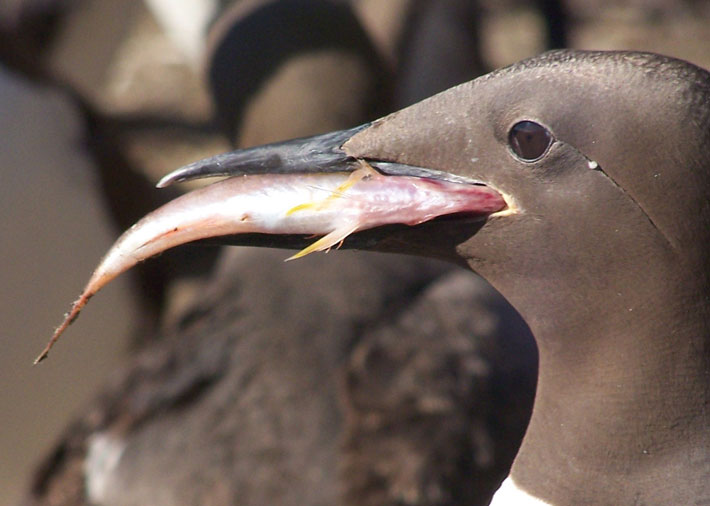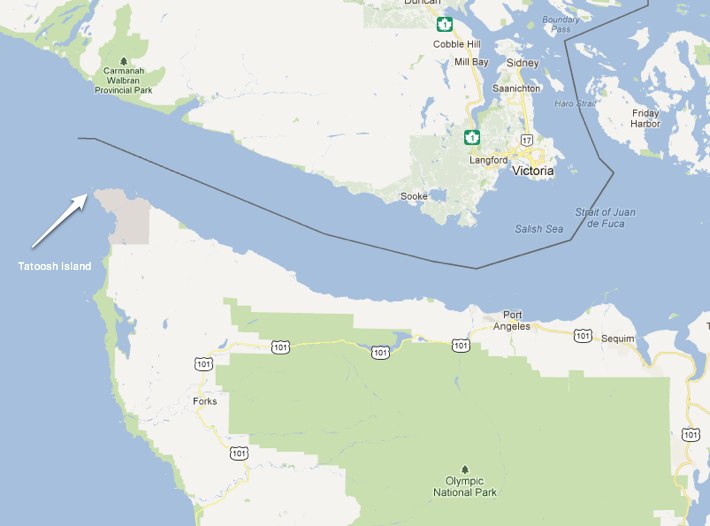
They don’t earn salaries or pay bills, but animal parents still must keep to a strict budget: an energy budget. If their chicks, pups, calves and cubs don’t get enough energy in their diet, they won’t survive.
An important new SeaDoc-funded study reinforces the theory that it’s not just the quantity of food that counts when raising kids, but also the quality. Michael Schrimpf, Julia Parrish and Scott Pearson found that changing environmental conditions have forced the Common Murres nesting on Tatoosh Island, Washington, to alter their grocery shopping patterns to successfully rear their chicks.
In an ideal world, Murre parents would bring home nothing but large, energy rich eulachon and herring, which provide chicks with a lot of caloric bang per fish buck.
However, shifting sea conditions and diminished populations of the best prey items can force Murre parents to bring their young “junk food,” in the form of smaller fish or alternate species that don’t add up to a good meal. Lower-quality prey means more fishing trips, which can stress parents and chicks. Seabird populations are designed to endure change, but persistent local declines of energy-rich prey can put them at risk. Understanding the factors that drive prey availability is key to conserving species like the Common Murre.
To learn more about the study, Common Murres, Tatoosh Island, and SeaDoc’s work on forage fish, read on.
The Study
ABSTRACT: Many productive ocean ecosystems are also highly variable, resulting in complex trophic interactions. We analyzed interannual patterns in the diet of a seabird, the common murre Uria aalge, in a region of high oceanographic productivity, the northern California Current, to investigate how these top predators adjust their chick provisioning to cope with environmental variability. Murres relied chiefly on Pacific herring Clupea harengus pallasi and surf smelt Hypomesus pretiosus to provision chicks, although they regularly returned 8 other fish taxa. Provisioning success was measured by the energy return rate to chicks, which in turn was disarticulated into energy per meal (quality) and meal delivery rate (quantity). Parents exhibited ‘compensation’ during 2 years in which smaller, low quality prey were returned more quickly than in years with normal (i.e. ‘good’) provisioning. Despite the increased delivery rate, energy return rates were still lower in ‘compensation’ vs. ‘good’ years. The lowest energy return rates occurred in 3 ‘poor’ years, during which ocean productivity was also depressed. Our results suggest that murres in this system have the ability to shift provisioning strategies to deal with some variability in prey resources, but not when limited by exceptionally poor environmental conditions.
The full scientific paper is here.
Murres on Tatoosh Island
Here's an audio recording made in the center of the Murre colony on Tatoosh in 2005, along with commentary on the status of the species, which was experiencing a heavy die-off of adult birds. The Murre sounds are at 2:45 and following in the recording. http://naturesound.libsyn.com/index/common-murre-on-tatoosh-island-wa
Current forage fish work
For an example of current activity in forage fish conservation, see the PDF agenda of the September 2012 research symposium, Conservation and Ecology of Marine Forage Fishes, put on by Friday Harbor Laboratories. The syposium included remarks by Joe Gaydos and the involvement of SeaDoc board member Kit Rawson, who works for the Tulalip Tribes.
Tatoosh Island
The island is at the western tip of Washington State, and belongs to the Makah Tribe.

Image by Google Maps
Photos:

Photo by Andy Karmy

Photo by C. Peterschmidt, USFWS Pacific
Video
Video of Common Murre in Washington: http://www.youtube.com/watch?v=rzcVxVzUnNI
